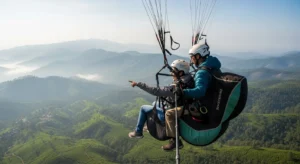
A cross-country road trip is more than just a vacation; it’s a rite of passage. It’s the ultimate symbol of freedom, discovery, and the vast, beautiful tapestry of America. But how do you transform this bucket-list dream into a well-planned, stress-free reality?
The answer lies in careful preparation. This comprehensive guide is your co-pilot, designed to navigate you through every stage of planning, from choosing a route to packing the car and hitting the open road.
Ultimately, this post will give you the confidence and the tools to plan and execute the adventure of a lifetime. The open road is calling, and with this guide, you’ll be ready to answer
.
Why Take a Cross-Country Road Trip?
Before diving into the logistics, let’s talk about the why. A cross-country road trip offers unparalleled freedom. Unlike a flight, you control the pace, the playlist, and the detours. Want to spend an extra day exploring a national park? You can. Stumble upon a quirky roadside attraction? It’s all part of the journey.
Moreover, this kind of travel fosters deep connections—with your travel companions, with the diverse cultures you encounter, and with yourself. It’s a chance to disconnect from the daily grind and reconnect with what truly matters. It is an investment in memories that will last far longer than any souvenir.
Phase 1: Planning Your Ultimate Cross-Country Road Trip
Proper planning is the foundation of a successful adventure. This initial phase is where you’ll make the big decisions that shape your entire journey. Consequently, spending time here will save you headaches later.
Defining Your “Why” and Timeline
First, determine the purpose of your trip. Are you seeking adventure in national parks? Exploring historical landmarks? Visiting friends and family? Your “why” will dictate your route.
Equally important is your timeline. A rushed trip can feel more like a chore than a vacation.
- 2-3 Weeks: Ideal for a one-way trip with focused stops. You’ll need to be selective.
- 4-6 Weeks: A comfortable pace for a one-way trip, allowing for more spontaneity and deeper exploration.
- 2+ Months: The gold standard for a round-trip journey, giving you ample time to see and do almost everything on your list.
Choosing Your Route: Coast to Coast Classics
America is crisscrossed with iconic highways. Each offers a unique flavor of the country. While you can certainly forge your own path, these classic routes provide a fantastic starting point for your cross-country road trip.
| Route Name | Approximate Miles | Key Highlights | Best Time to Go |
| The Northern Route (US-2 / I-90) | 3,000 | Pacific Northwest, Glacier NP, Yellowstone NP, Badlands NP, Chicago | Late Spring to Early Fall |
| The Historic Route 66 | 2,400 | Chicago, St. Louis, Grand Canyon, Classic Americana, Santa Monica | Spring & Fall |
| The Central Route (I-80) | 2,900 | San Francisco, Salt Lake City, Rocky Mountains, Des Moines, New York City | Late Spring to Early Fall |
| The Southern Route (I-10) | 2,500 | Los Angeles, Phoenix, New Orleans, Florida’s Gulf Coast | Fall, Winter, & Spring |
Remember, these routes are just skeletons. The real magic happens when you venture off the interstate to discover the towns and landscapes in between.
Budgeting for Your Cross- Country Road Trip Adventure
A common question is, “How much does a cross-country road trip cost?” The answer varies wildly based on your travel style. However, you can create a reliable estimate by breaking down the major expenses. For a deep dive into trimming costs, explore these actionable tips for saving money on your road trip.
Major Budget Categories:
- Fuel: This will likely be your biggest expense. Use an app like GasBuddy to estimate costs based on your vehicle’s MPG and your planned route.
- Lodging: This can range from free (camping on public land) to expensive (luxury hotels). A mix of motels, Airbnb, and camping is a great way to balance comfort and cost.
- Food: Eating out for every meal adds up quickly. Plan for a mix of restaurant meals, fast food, and groceries you can prepare yourself. A good cooler is your best friend.
- Activities & Attractions: Factor in costs for national park passes, museum tickets, and other planned excursions. An America the Beautiful Pass is a must-have for visiting multiple national parks.
Picking Your Ride: Vehicle Prep and Rentals

Your vehicle is your home on wheels. Therefore, ensuring it’s in top condition is non-negotiable. Before you go, get a full tune-up: check the tires, brakes, fluids, and battery.
If your car isn’t up for the journey, consider a rental. Look for companies that offer unlimited mileage and allow for one-way drop-offs if needed. A comfortable and fuel-efficient vehicle will make your cross-country road trip significantly more enjoyable.
Phase 2: Packing Essentials for the Open Road
Packing for a long road trip is an art form. You need to be prepared for various climates and situations without overpacking the car. Organization is key.
The Ultimate Cross-Country Road Trip Packing List

Think in categories to ensure you don’t miss anything. For a truly exhaustive list you can print and use, check out this road trip essentials checklist.
- Vehicle Essentials: Jumper cables, tire pressure gauge, spare tire kit, car fluids, paper maps (for when GPS fails), and your vehicle’s manual.
- Clothing: Pack layers. Include comfortable driving clothes, walking shoes, something for a nice dinner, a rain jacket, and swimwear.
- Technology: Phone mounts, car chargers, a portable power bank, and any camera gear. Download playlists, podcasts, and maps for offline use.
- Comfort & Health: A first-aid kit, any personal medications, sunscreen, insect repellent, pillows, and blankets.
- Food & Drink: A high-quality cooler, reusable water bottles, a thermos for hot drinks, and a basic set of utensils.
Don’t Forget the Fun Stuff!
Long stretches of driving require quality entertainment. Beyond a great playlist, think about what will keep you and your companions engaged. Fun road trip games can turn a boring highway into a source of laughter.
In addition, consider packing items that enhance your downtime. This could be a good book, a journal, a frisbee, or even unique items like specialty wellness products. Some travelers pack items like these specialty mushroom gummies to help them relax and unwind after a long day of driving. The key is to pack things that help you enjoy both the drive and the destinations.
Phase 3: Hitting the Road: Tips for a Smooth Journey
You’ve planned, you’ve budgeted, and you’ve packed. Now it’s time for the best part: the drive. Here’s how to make your time on the road smooth, safe, and unforgettable.
Navigating and Finding Stops
While GPS is essential, don’t rely on it exclusively. Apps like Roadtrippers and The Dyrt are fantastic for discovering quirky roadside attractions and campsites. For an authoritative source on natural wonders, the official National Park Service website is an invaluable tool for finding parks and monuments along your route.
Staying Safe on Your Cross-Country Road Trip
Safety should always be a top priority. Share your itinerary with someone back home and check in regularly. Be aware of your surroundings, especially at rest stops and overnight locations. Lock your vehicle and keep valuables out of sight. For more detailed advice, resources like AAA’s road trip safety tips provide excellent, up-to-date information.
Eating Well Without Breaking the Bank
Embrace the grocery store. Start your day with a simple breakfast at your campsite or motel. Pack lunches and snacks to avoid expensive and often unhealthy roadside food. This not only saves money but also gives you the flexibility to have a scenic picnic lunch wherever you find a beautiful spot.
Making the Miles Fly By
The journey is as important as the destination. Make the driving portion of your cross-country road trip an experience in itself.
- Listen Up: Dive into long-form podcasts or an engrossing audiobook series.
- Talk It Out: Meaningful conversation can make hours disappear. Use a list of thought-provoking road trip questions to spark new discussions with your travel partners.
- Practice Presence: Don’t treat driving as a chore. Pay attention to the changing.
- landscapes, the local radio stations, and the rhythm of the road.
Traveling with Company: Partners, Friends, and Pets

A cross-country road trip can be a powerful bonding experience, but it can also test relationships. Communication is crucial. Discuss expectations beforehand, be willing to compromise on plans, and make sure everyone gets some alone time.
Traveling with companions requires extra thought. For instance, planning a trip with a partner and an animal, especially an older one, has its own unique set of challenges and rewards. For those in that specific situation, finding tips for a couple’s road trip with a senior dog can be incredibly helpful. The same principles of patience and preparation apply to any travel group.
Frequently Asked Questions (FAQ) about a Cross-Country Road Trip
Here are clear, concise answers to some of the most common questions about planning this type of adventure.
Q. How long does a cross-country road trip take?
A. To drive from one coast to the other takes approximately 45-50 hours of pure driving time. To enjoy the journey, plan for at least two weeks for a one-way trip. For a more relaxed pace with plenty of stops, four to six weeks is ideal.
Q.How much does a cross-country road trip cost?
A. A budget-focused cross-country road trip can cost between $2,000 and $4,000 for a one-way, two-to-three-week trip for two people. This includes gas, budget lodging, and a mix of self-prepared meals and restaurants. A more comfortable trip could be $5,000 or more.
Q.What is the best time of year to go on a cross-country road trip?
A.Late spring (May-June) and early fall (September-October) are generally the best times. You’ll avoid the peak summer crowds and extreme heat in the south while still having pleasant weather for northern routes.
Q.What is the best vehicle for a cross-country road trip?
A.The best vehicle is one that is reliable, comfortable, and fuel-efficient. A mid-size SUV often provides a great balance of space and economy. However, any well-maintained car can work. The most important factor is reliability.
Conclusion: The Journey Awaits
A cross-country road trip is the ultimate adventure, a chance to write your own story on the canvas of America. It’s about more than just seeing new places; it’s about the person you become along the way.
By planning thoughtfully, packing smartly, and embracing the unexpected, you can turn this dream into your reality.
You have the map, the tools, and the inspiration. The only thing left to do is put the car in drive. Your epic journey awaits.






шкаф в паркинг москва шкаф в паркинг москва .
займы на карту срочно без проверки [url=https://www.zajm-kg-3.ru]займы на карту срочно без проверки[/url] .